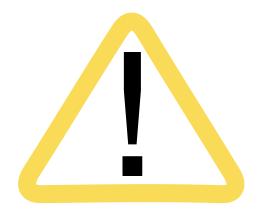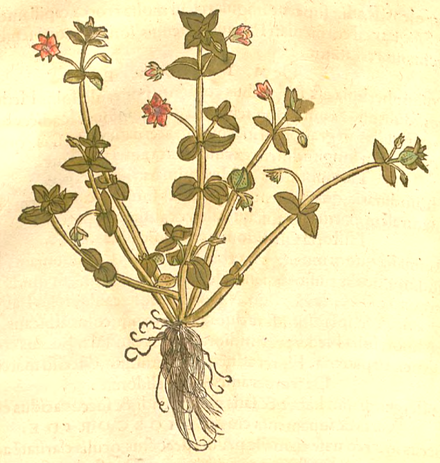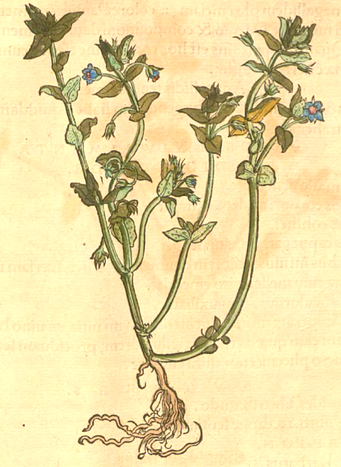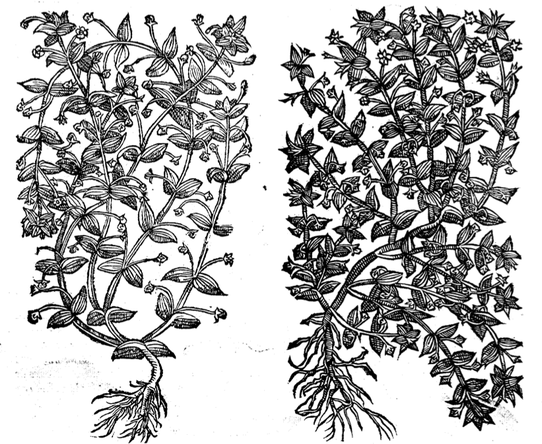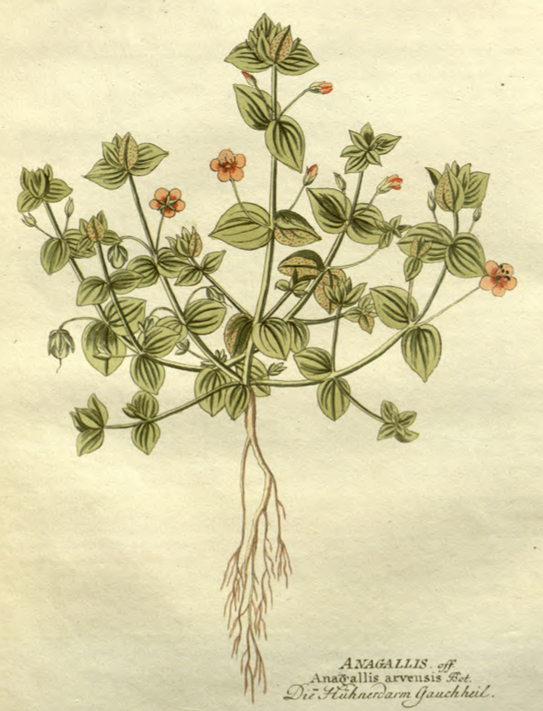Sentry Page Protection
Male (Left) and Female (Right)
Herbarum Vivae Eicones, Otto Brunfels, 1530
Herbarum Vivae Eicones, Otto Brunfels, 1530
Male (left) and Female (right)
Dioscorides Materia Medica, Mathias, 1563
Dioscorides Materia Medica, Mathias, 1563
Icones Plantarum Medcio-oeconomico, Vietz, 1800
Botanical name:
Anagallis arvensis
Two varieties are known, both used similarly:
1. ‘Male’ is red (‘Scarlet’, A. arvensis);
2. ‘Female’ with blue flowers (A. cerulea and A. foemina)
A. phoenicea has also been used.
Parts used:
Herb (fresh or dried)
Galen said the Blue-flowered variety is most effective, although in general, the red 'Scarlet Pimpernel' is preferred.
Temperature & Taste:
Cool (some said Warm), dry. Bitter, Sour
Cleansing, anti-inflammatory
Classification:
B. Clear Heat
Anagallis arvensis
Two varieties are known, both used similarly:
1. ‘Male’ is red (‘Scarlet’, A. arvensis);
2. ‘Female’ with blue flowers (A. cerulea and A. foemina)
A. phoenicea has also been used.
Parts used:
Herb (fresh or dried)
Galen said the Blue-flowered variety is most effective, although in general, the red 'Scarlet Pimpernel' is preferred.
Temperature & Taste:
Cool (some said Warm), dry. Bitter, Sour
Cleansing, anti-inflammatory
Classification:
B. Clear Heat
Uses:
1. Clears Heat, Resists Poison (TCM, West)
-Common Cold; Contagious and Epidemic diseases (boiled in wine)
-Venomous Bites: Bites of Snakes, Rabid Dogs (TCM, West)
-"useful in Snake-bite when taken with wine". (Avicenna)
-'useful in snake-bite when taken with wine' (Avicenna)
-Nettle rash; Poison Oak; Pruritus (int. & ext.)
-Seafood Poisoning (in Taiwan)
2. Clears Heat and Damp, Promotes Urine:
-Edema, Burning Urine
-Gravel and Stones of the Bladder or Gall Bladder
-"useful for Nephralgia when given with wine". (Avicenna)
-Pain and Ulcers of the Kidney or Bladder (Culpeper)
3. Calms the Liver, Stops Wind, Calms the Mind:
-Epilepsy (TCM, West)
-Melancholy, Depression, Mental Illness, Madness, Mania (TCM, West)
4. Moves the Blood, Resolves Swellings, Promotes Healing: (TCM, West)
-Scrofula, Swellings, Inflammations, Tumors, Cancer
-Liver and Spleen Swelling; Hepatitis
-chronic Sores or Slow-healing Wounds from poor circulation (no redness or inflammation) (TCM)
5. Clears Liver Heat, Benefits the Eyes:
-red, swollen painful eyes; Blood-shot eyes
-trauma, bleeding or films on the Eyes (Pliny)
-poor or dim eyesight (Galen)
6. Externally:
-Wounds; Old, Foul and 'Running' Ulcers (int. and ext.) (since Dioscorides)
-"Both the kinds cleanse the Wounds, stop their Swellings, pull out the Thorns and other foreign bodies and prevent
spreading of Ulcers". (Avicenna)
-decoction or distilled water ‘old filthy fretting and running Ulcers, which it very effectually cureth in short spaces’ (Culpeper)
-applied to Piles
-cosmetic for Freckles and Spots, and to improve Complexion
-draws Thorns and Splinters (since Dioscorides)
-as a snuff or gargle to purge the Head
-Juice has been used for Toothache: snuffed up the opposite nostril (since Dioscorides)
-applied with Honey for dimness of sight (since Dioscorides)
Dose:
Taken with or boiled in wine to promote Urine, for Viper bites, and Liver diseases.
Powder: 500mg–2 grams;
Tincture (1:5): 1–3 mls.
Decoction: 6–12 grams
Taken with or boiled in wine to promote Urine, for Viper bites, and Liver diseases.
Powder: 500mg–2 grams;
Tincture (1:5): 1–3 mls.
Decoction: 6–12 grams
Main Combinations:
1. For Melancholy:
i. Scarlet Pimpernel with Borage
ii. Scalet Pimpernel, St. John's wort, Balm
iii. Scarlet Pimpernel, Borage, Fumitory, Senna
iv. Scarlet Pimpernel, Borage, Apple, Sal Prunella
2. Depression or Mental illness:
i. Scarlet Pimpernel with St. Johns wort
ii. Scarlet Pimpernel, Borage, Balm
3. Against Poison and Infection,
i. Scarlet Pimpernel, Blessed Thistle, Angelica, Zedoary
ii. Scarlet Pimpernel, Cinnamon, Tormentil, Aloe, Juniper berry, Blessed Thistle, Angelica
4. Inflammation of the Liver, Scarlet Pimpernel with Liverwort, Walnut leaf, Juniper berry, Heartsease, Alder Buckthorn (Frangula) bark (Ulrich)
5. Liver hardness, Scarlet pimpernel with Rhapontic, Indian Spikenard, Asarum, Agnus Castus, Senna (as in Troches Proven for Hardness of the Liver of Nicolas)
6. Gall Stones, Scarlet Pimpernel with Bitter Orange peel, Centaury, Dandelion, Chicory root, Calamus, Couch Grass, Hemp Agrimony (Kroeber)
7. Consumption, distilled Waters of Scarlet Pimpernel and of Cow's Milk in equal parts
8. Poor eyesight, mix the juice with Honey (Galen)
Major Formulas:
Troches Proven for Hardness of the Liver (Nicolas)
Cautions:
1. Large doses are narcotic
2. Not used for more than 3 or 4 weeks without a break in treatment.
3. Not used in Blood deficiency
4. Avoid in Nephritis, Kidney or Liver disease
Main Preparations used:
Distilled Water of the whole plant, Tincture
1. TINCTURE of PIMPERNEL.
Fresh Pimpernel leaves 10 oz.
Diluted Alcohol 1 pint
Steep for a week, then strain. Dose: 1-5 drops
1. Large doses are narcotic
2. Not used for more than 3 or 4 weeks without a break in treatment.
3. Not used in Blood deficiency
4. Avoid in Nephritis, Kidney or Liver disease
Main Preparations used:
Distilled Water of the whole plant, Tincture
1. TINCTURE of PIMPERNEL.
Fresh Pimpernel leaves 10 oz.
Diluted Alcohol 1 pint
Steep for a week, then strain. Dose: 1-5 drops
Click the Tabs above for more information on this Medicine
Pliny on Anagallis:
|
'The anagallis is called "corchoron" by some. There are two kinds of it, the male plant, with a red blossom, and the female, with a blue flower. These plants do not exceed a palm in height, and have a tender stem, with diminutive leaves of a rounded form, drooping upon the ground. They grow in gardens and in spots covered with water, the blue anagallis being the first to blossom. The juice of either plant, applied with honey, disperses films upon the eyes, suffusions of blood in those organs resulting from blows, and argema [blood-shot eyes] with a red tinge: if used in combination with Attic honey, they are still more efficacious. The anagallis has the effect also of dilating the pupil; hence the eye is anointed with it before the operation of couching for cataract. These plants are employed also for diseases of the eyes in beasts of burden.
|
The juice, injected into the nostrils, which are then rinsed with wine, acts as a detergent upon the head: it is taken also, in doses of one drachma, in wine, for wounds inflicted by serpents. It is a remarkable fact, that cattle will refuse to touch the female plant; but if it should so happen that, deceived by the resemblance— the flower being the only distinguishing mark— they have accidentally tasted it, they immediately have recourse, as a remedy, to the plant called *'asyla," but more generally known among us as "ferusoculus." Some persons recommend those who gather it, to prelude by saluting it before sunrise, and then, before uttering another word, to take care and extract the juice immediately; if this is done, they say, it will be doubly efficacious.' (The Natural History of Pliny, trans. by Bostock and Riley, Vol. 5, 1856)
|
Last Updated 02/24

